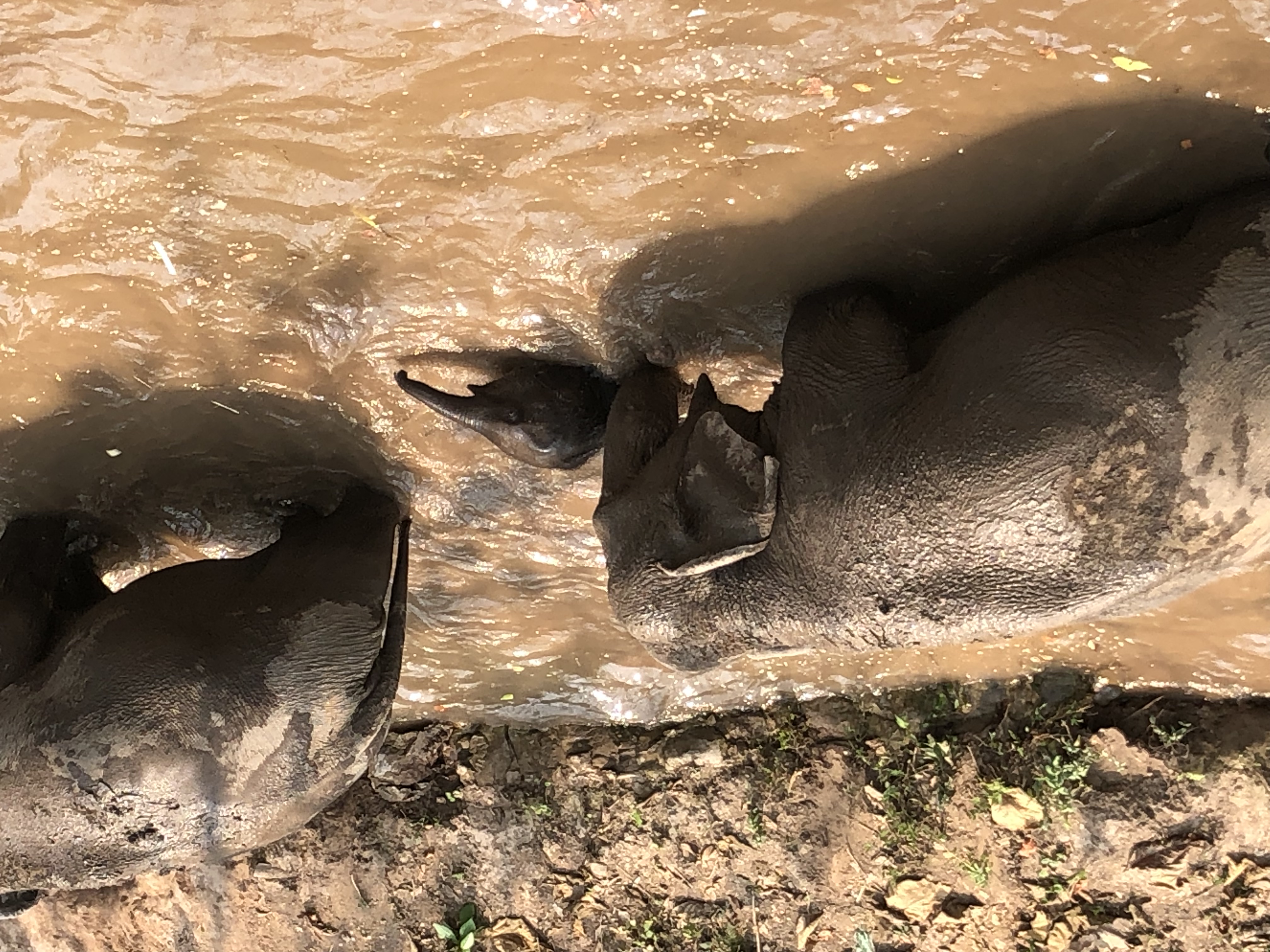
After a day on the uncomfortable and rather crappy slowboat between Huay Xai and Pak Beng (which on previously blogs I may have called Pakbeng), on the way to Luang Prabang, we woke to find the river valley blanketed in smoke from the many fires farmers had lit along the river, and perhaps even in neighbouring countries. I’ve only ever seen worse smoke during the Black Summer bushfires in Australia in 2019-20 that frequently left the south coast of New South Wales, and the city of Canberra where we were living at the time, engulfed in smoke for days at a time.

We were so nervous about the smoke. It had been lingering and following us for the last week when we had been in northern Thailand. The hotel didn’t offer much of a sanctuary, with the doors in our room not quite sealing properly, and being ever so slightly ajar, which let a little of the smoke it. Otherwise the hotel was nice, despite the aircon also not being very powerful and just barely managing to keep us a little cool overnight in the horrendously high heat (but just enough). I suggested to my wife that we try and cut short our stay in Pak Beng – which we’d scheduled for 3 nights and head to Luang Praband a bit earlier, perhaps the next day, and then, if Luang Prabang was too smoky too, to head over to Vietnam a few days earlier. But, one thing thwarting that plan were visas. Pinche (Spanish for lousy or crappy) visas! We’d gotten our Vietnam visas online already and we couldn’t enter for another 10 days or so. A good tip with visas is to put your entry date a week or so before you think you’re going to enter so you can allow yourself a bit more flexibility (really a note to myself as I was in charge of all that!). You usually can’t alter visas once you’ve got them so the only other option is usually to apply for another whole visa – which, thanks to the internet, I started the process for the next day, but which turned out to not be as the first one I applied for.
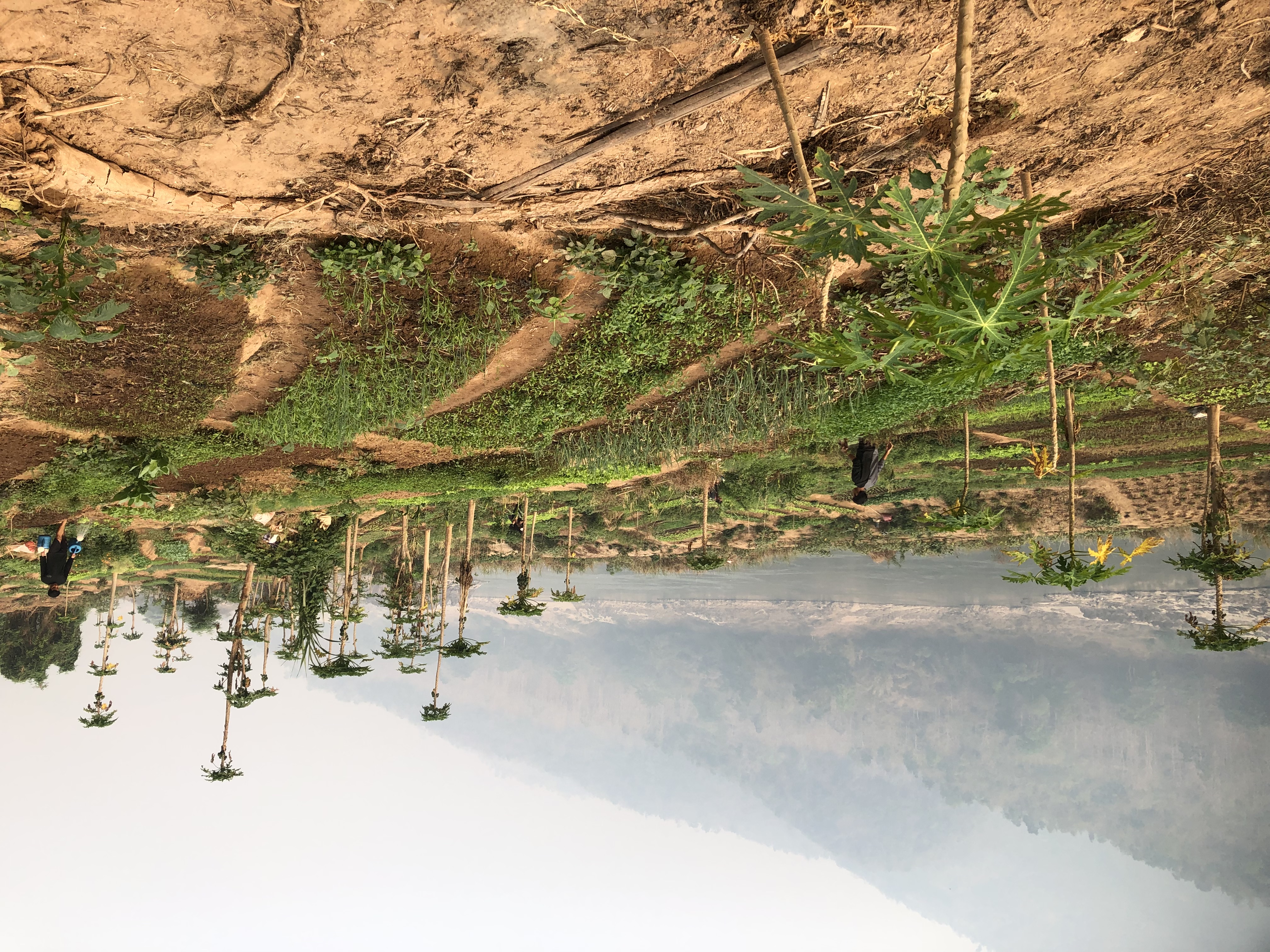
While we contemplated an escape from the smoke, which felt like smoking 30 Marlboro Reds (the cowboy strength cigarettes) a day, we embarked on our booked excursion to the Mekong Elephant Park, which was just across the Mekong from our hotel, and which was the one and only reason we’d decided to stay in Pak Beng. In terms of booking, we’d been emailing back and forth to organise a date for the past few weeks, perhaps even a month, sometimes emailing the elephant sanctuary organiser Helen and other times the hotel owner, Benoit, who was helping organise things. Once we arrived at the hotel we realised Helen and Benoit were wife and husband. Benoit ran the hotel bit and Helen the elephant park bit, or so it seemed to me – actually Helen may have even said that to me. So there was a bit of cross-over with communications. In the end they weren’t too fussed with the bookings and were relaxed and flexible, at least during these off peak times, and were happy to change the days about to fit our schedule. I mean the park was literally directly across the river from the hotel which was not exactly overflowing with guests at this time of year with the pinche heat (hovering around the high 30s and perhaps even low 40s, Celsius) and smoke. I can’t overstate the heat in that region at that time of year (mid-April) – well I can I guess but that’d be rather subjective – and we were going through litres and litres of water each day, plus several showers.
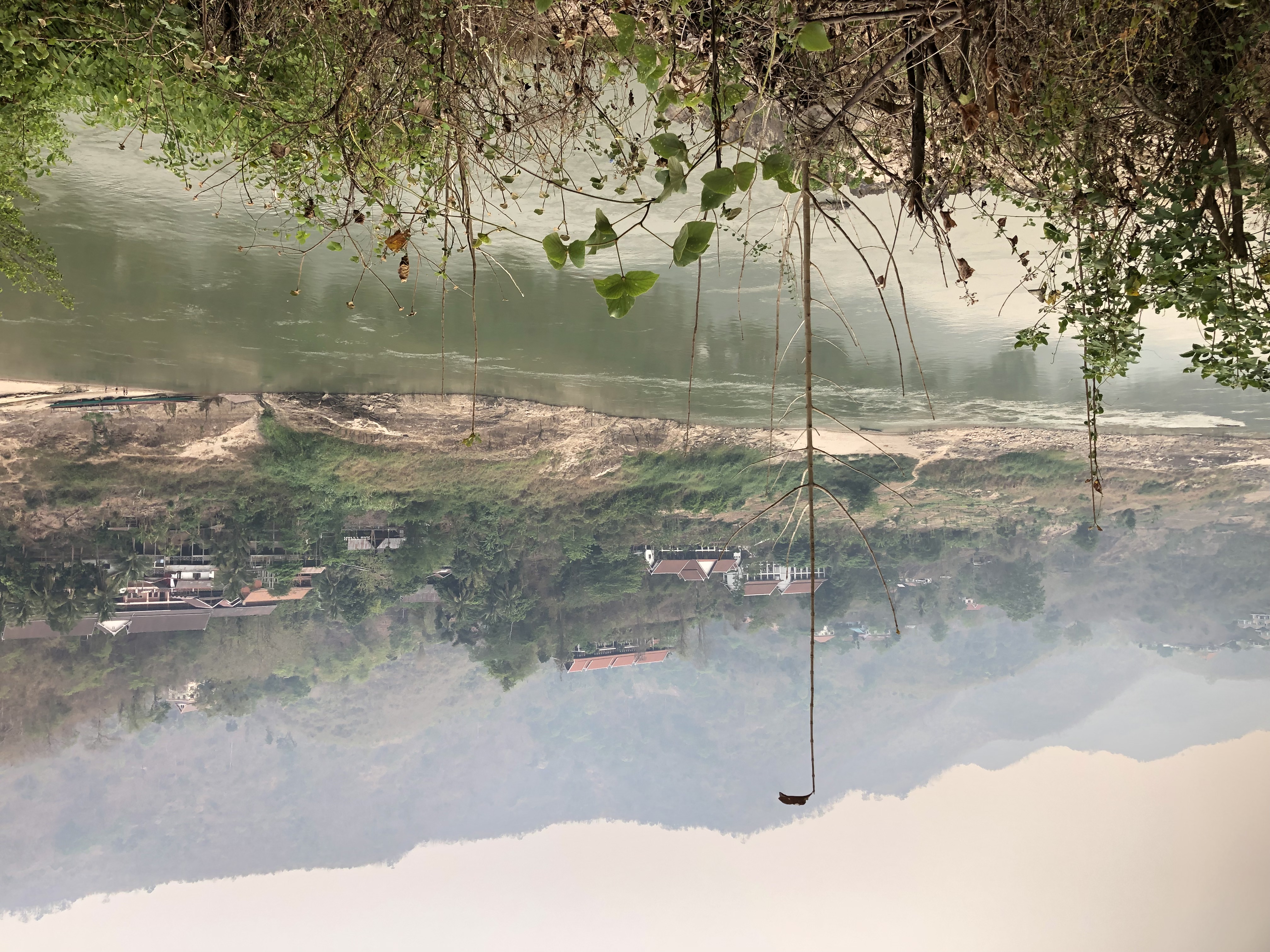
After a decent but rather average breakfast – don’t expect great culinary delights in Pak Beng, though the food in town is decent enough – we headed down to the bottom of the hill to the high season (I think around November-February) reception part of the hotel, to wait to go down the hill further for our boat ride to the park. Pak Beng is very hilly, and even more hilly at this time of year when the Mekong was low, perhaps at its lowest, level. We met a nice Canadian woman, also waiting for the elephant park adventure, and started chatting to her. She was the only other person going over the park today. Most tourists appear to just stay one night in Pak Beng, after a long day on the slowboat from Huay Xai or Luang Prabang (depending on the direction they had been going – look at a Google map and you’ll get the idea), and then just get up early then do another day on the slowboat onto Luang Prabang (or Huay Xai if you had started at Luang Prabang). And, especially at this time of year there were few left to undertake any activities in and around Pak Beng.
There we were, three of us crazy ones, in the smoke and already almost blistering dry and dusty heat, despite it only being around 9 am. After a while Helen came up and introduced herself and explained the upcoming day’s activities over at the elephant park. We then crossed over the river in a little boat and we sat down in the jungle and Helen explained the philosophy behind the park. The elephants there were all rescue animals and the park tried to keep them in as close to their (the elephant’s) natural state as possible with an eventual aim of breeding up the elephant population to build up the ever dwindling wild elephant population in Laos, which was then around 800, but possibly as low as 600. They were trying to conserve rather than exploit the elephants. Helen explained we weren’t going to be able to ride, or bathe with the elephants or see them doing any circus tricks. We were just going to go along and watch them walk, and walk along with them, as they did natural elephant things.
The decline in elephant numbers was almost entirely due to human activity and had nothing to do with tigers I found out. Helen informed me that tigers were now extinct in Laos (no tigers have been seen in the wild there since 2013), a fact that was as almost disappointing to hear as the small number of elephants that now remained in the wild in the country – that was still called the Land of a Million Elephants. The stories we tell ourselves when reality is around 999, 200 to 999,400 short of the mark. As a side note, Otto English has written a good book called Fake History, which details the lies and exaggerations we tell ourselves. Like the Australian state of Tasmania still having the Thylacine (Tasmanian Tiger) as an emblem despite European settlers having killed them all off around the 1930s when my favourite travel writer, Patrick Leigh Fermour, was making his way from Holland to recently renamed Istanbul (once Constantinople). Or Berlin still having the bear as it’s city’s symbol even though they were hunted to extinction around 300 years ago.
And still, despite the numbers of elephants dwindling, most of the tourist souvenirs feature elephants. Us humans can be quite delusional at times. Let’s see hope we go with climate change. I’m not that optimistic about our chances.
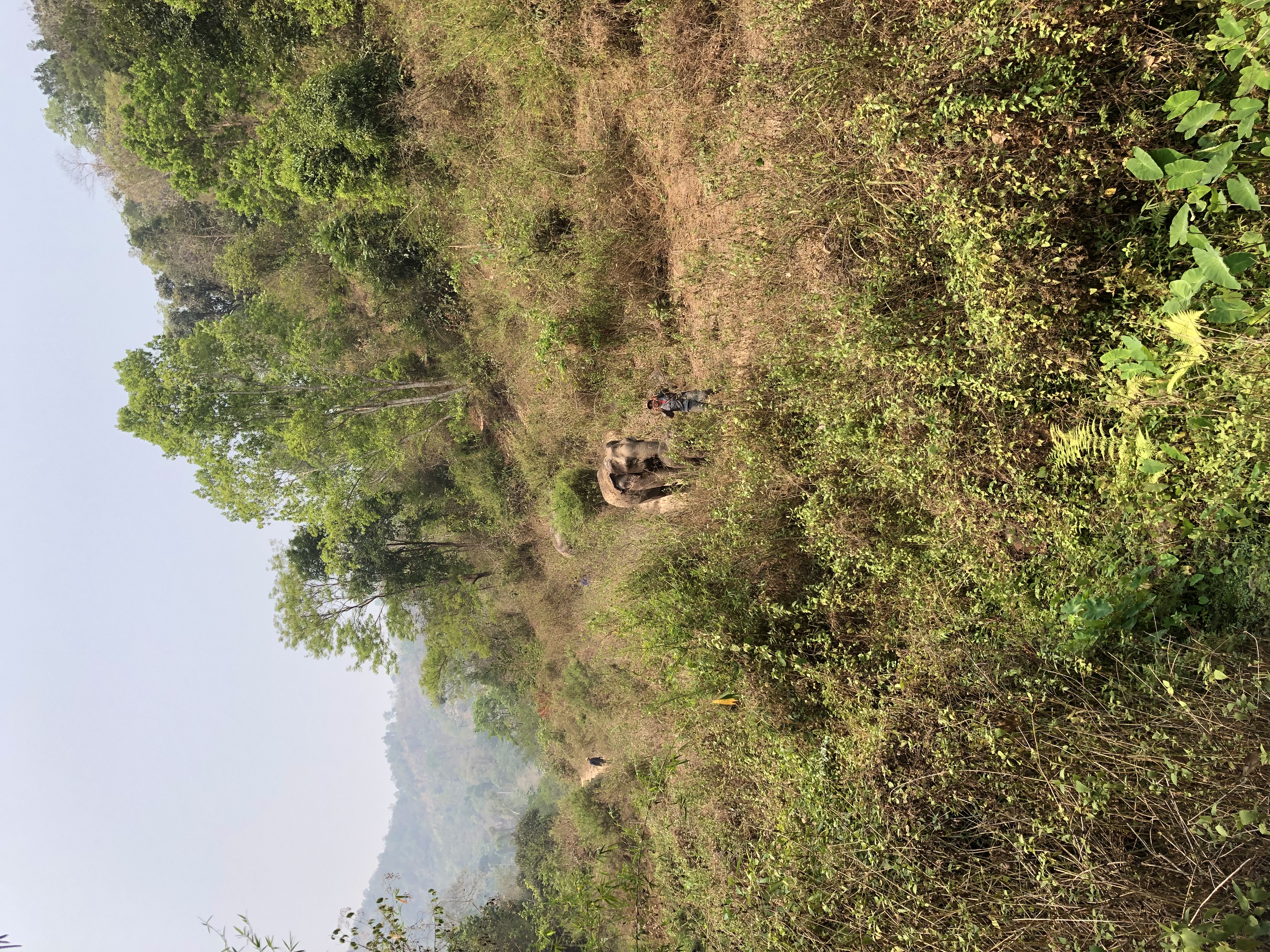
Helen was fantastic, she was so positive and knowledgeable about elephants. Our foreboding about the smoke quickly lifted as we were transported into elephant world which was also helped by the smoke literally easing off a bit. It was still there but rather than blanketing us it just sort of hovered about. Perhaps the jungle trees helped or maybe the valley we’d made our way into after the chat with Helen, with high hills on either side, offered us some protection. After the chat we were introduced to our first elephant, the oldest one, a female – she had a name, but not sure she knew that, and I’ve forgotten it – who suddenly appeared from a small dusty trail that led down from the jungle with amazing stealth. Elephants aren’t that rowdy it would seem, perhaps they wanted to make sure the long-extinct tigers didn’t hear them. I asked Helen about the affect of having a top predator, like a tiger, leaving an ecosystem.
‘Humans do that job well enough’, she said, or words to that affect, it’s difficult to capture people’s quirks of descriptions at times.
Being from Australia, I asked about whether we had to be careful of snakes, particularly cobras, which I would have loved to have seen (from a safe distance).
‘The Mahouts, saw a baby cobra the other day and cooked it up.’ Again words to that affect, apologies Helen, all writing is somewhat fictional.
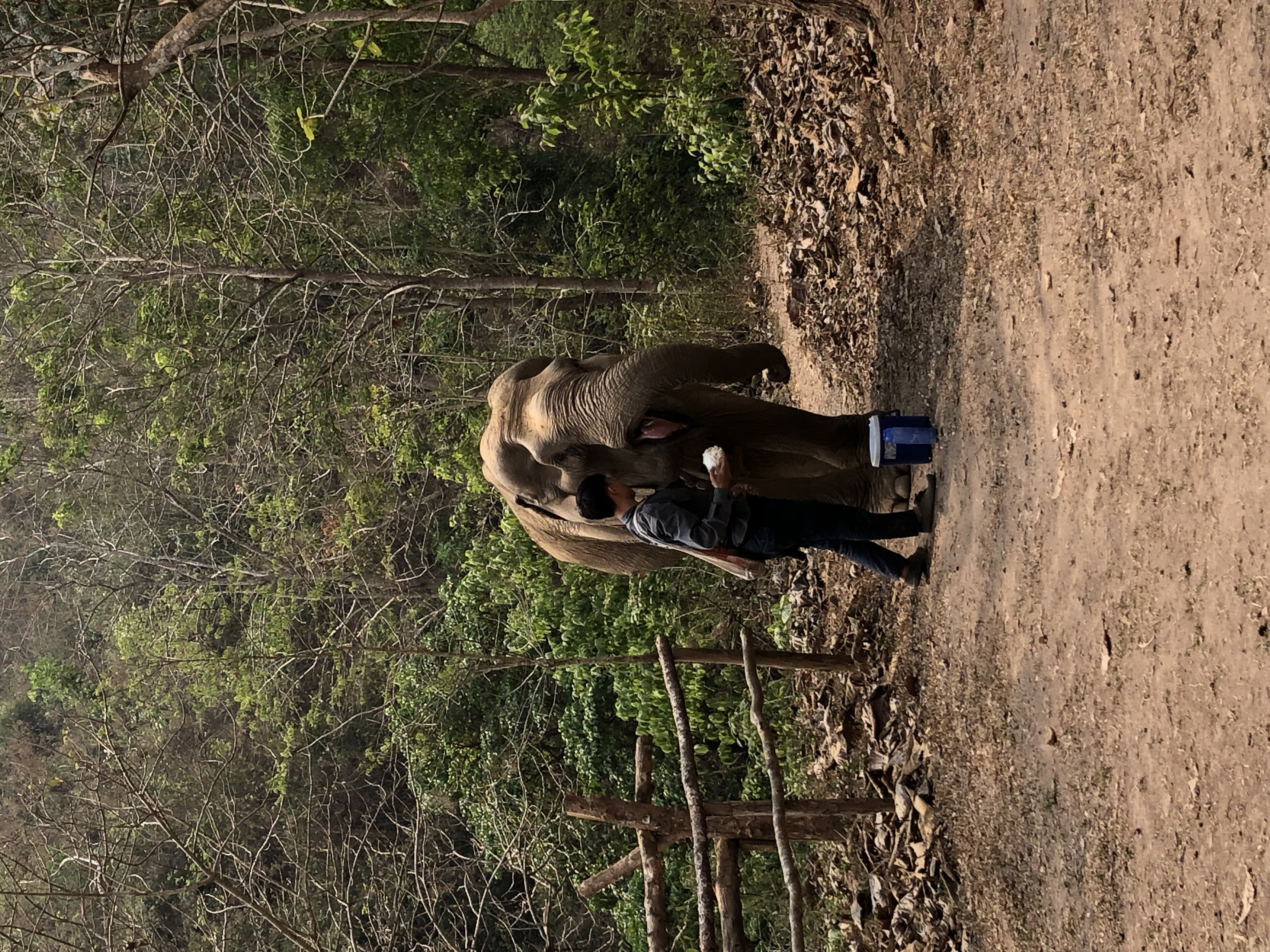
The Mahouts were the elephant handlers. ‘That’s not nature!’ You might say. Well I did say they were trying to keep the elephants in as natural state as possible, but just letting them roam about on their own was not possible anymore. Elephants are very valuable, and even in a Buddhist country, with one of the Buddhist precepts being Not to Steal Stuff, an elephant may end up being stolen, or even used for meat, or Chinese medicine, or put to work logging. Laos is still a very poor country and most people live a kind of subsistence lifestyle – especially outside the few big cities (basically Vientiane and, to a lesser extent, Luang Prabang. I did ask Helen many non-tiger and non-cobra, actual elephant questions which she was very happy to answer, but I also threw in some general Laos ones. I asked about the people we’d seen along the river who had been panning for some sort of minerals. They were panning for gold she said. There was hardly any gold about, but with the river being so low this time of year they could access the alluvial sands and perhaps get a few specs to supplement their meagre income. We had seen them all along the river as we spent the many hours travelling to Pak Beng. Along with lots and lots of buffaloes!
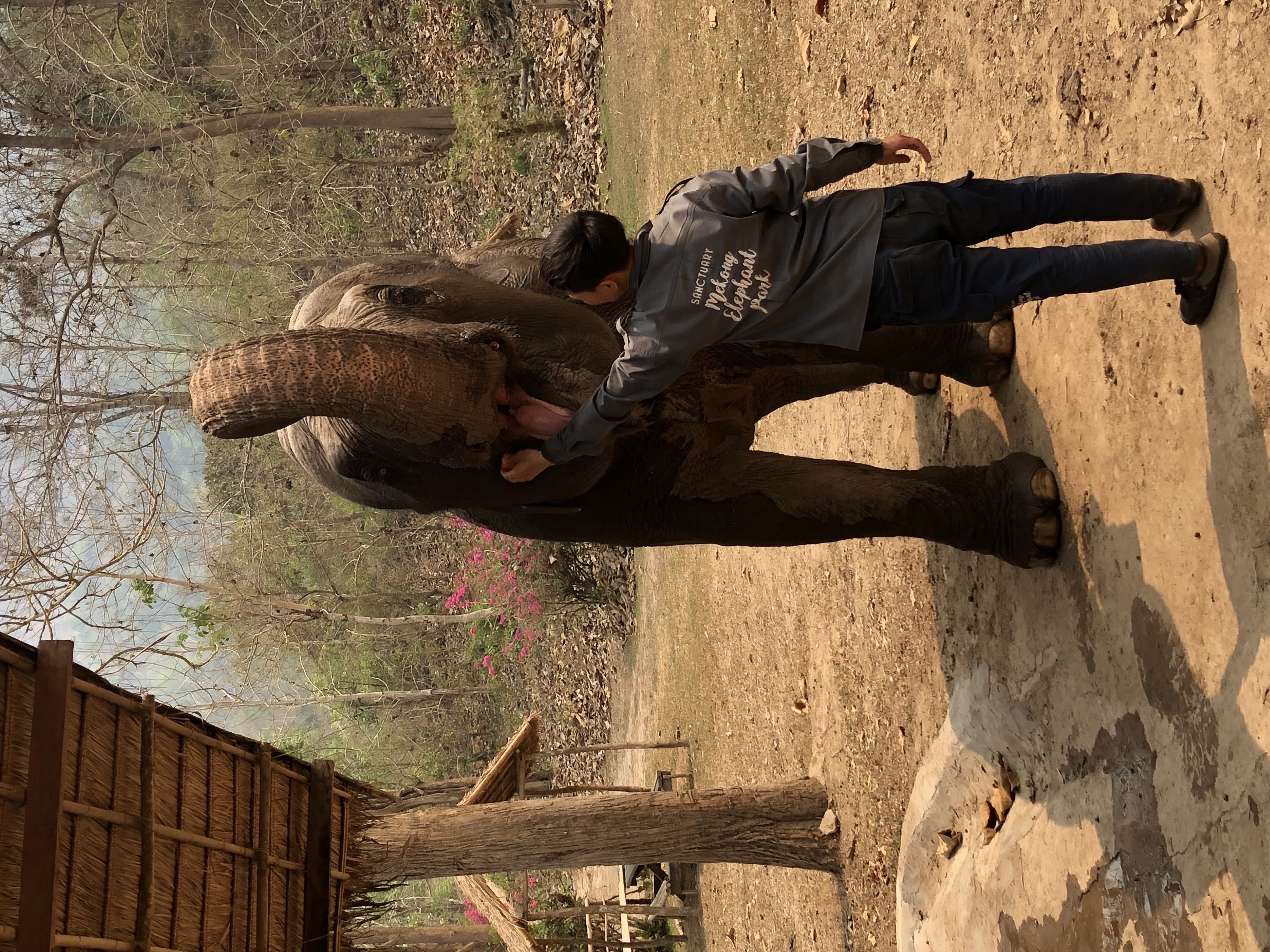
Back to the Mahouts. They tended to the elephants, following them around their whole lives, sleeping in the jungle through smoke, rain, heat, with no aircon to speak of, avoiding/ eating cobras and other dangerous/ edible creatures. Practically everything is edible it seems in Laos, and they also had to ban people from eating a pretty bird, a kind of swallow or something, that was currently nesting around the town (town being perhaps a little grandiose a description for what was more like a river-side villager). A Mahout would be allocated a younger elephant when they were also young and they’d grow old together, which worked out well as the older elephants would slow down a bit at the same time the Mahouts were also slowing down. While each elephant did have a primary Mahout, there were back up ones that could step in and take over an elephant when the main Mahout had breaks and went back to visit their families, who they’d see less than the elephants.
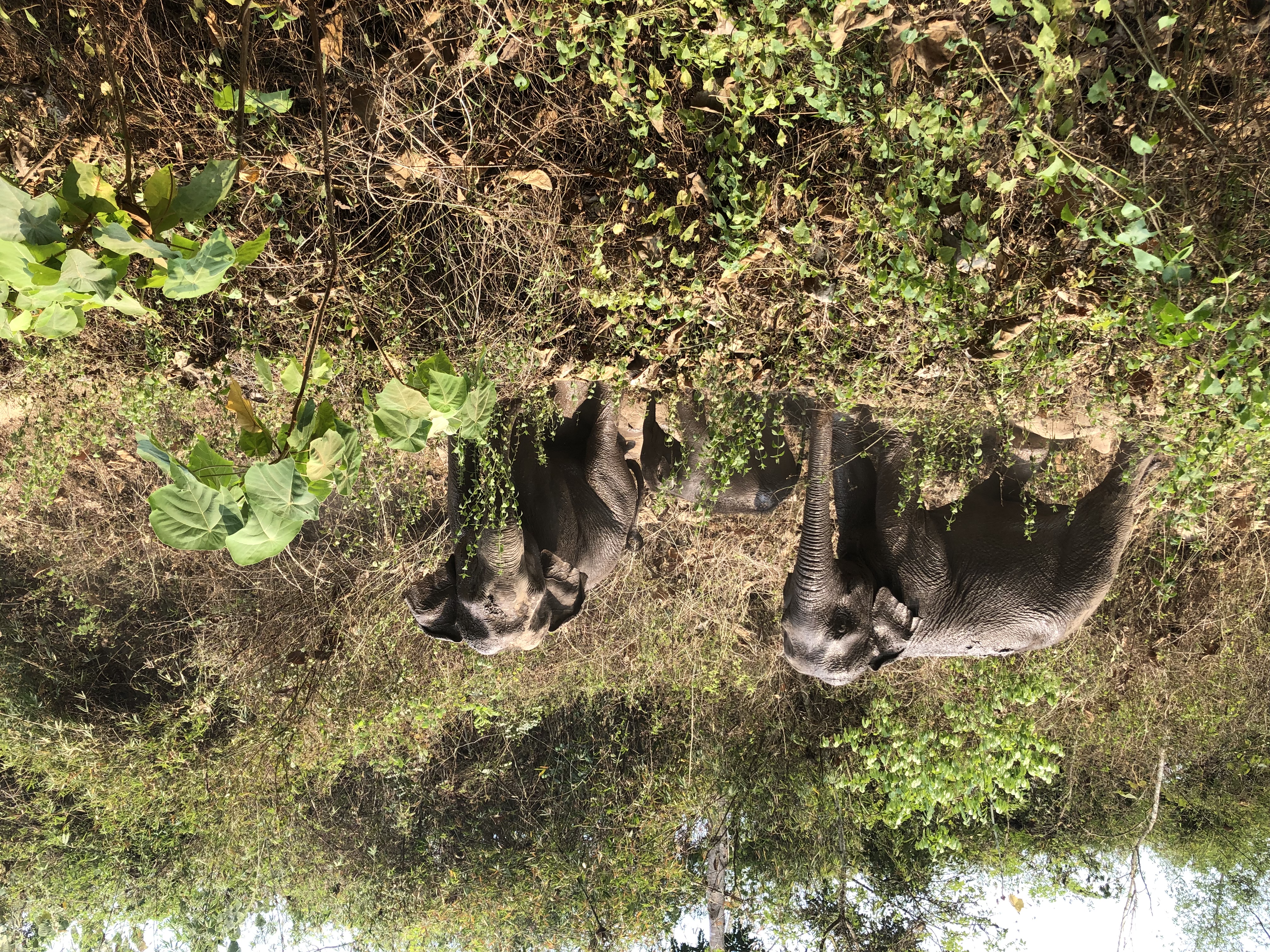
The Mahouts also kept and eye on the elephants medical needs and helped treat them for scratches cuts and the like, along with Helen and the western medicine she brought, which could become fatally infected. Helen was no French colonial slouch when it came to elephant care. She also spent days and weeks out in the jungle with the elephants and the Mahouts. She had also learnt Laos in order to communicate with Mahouts. The Mahouts also seemed to get a fairly decent wage and the Pak Beng community were seeing the benefits of increased tourist trade since the elephant park opened, so it was a win for the environment and a win for the local economy. I hope we can see more of such things and less human-centric exploitative tourism.
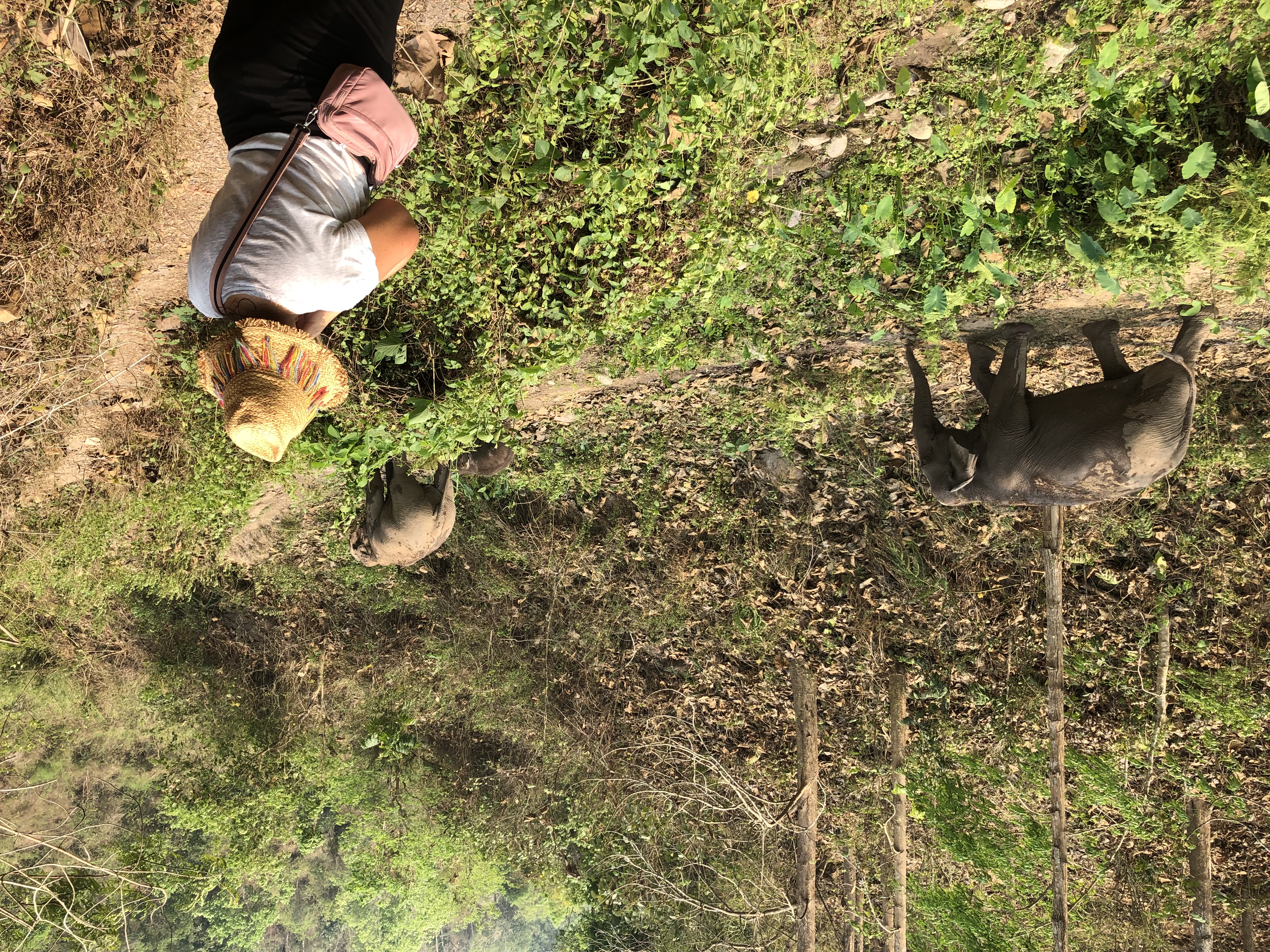
The older female elephant walked off to do some medical checks or something. We walked further into the valley until we came to a fork in the path. Helen called down the valley to the Mahouts hidden somewhere in the jungle to work out which direction we should go to find the elephants, as the elephants, to a large extent, determined where they hung out and the Mahouts just tagged along for company/ protection. The Mahout yelled back. Again, this is my memory, it’s likely to be at least partially fictional. We walked up the path a bit to find the other elephants. And then maybe 200 metres along, we met the stars of the show, the little baby elephant, maybe 6-8 months old, I can’t recall exactly.
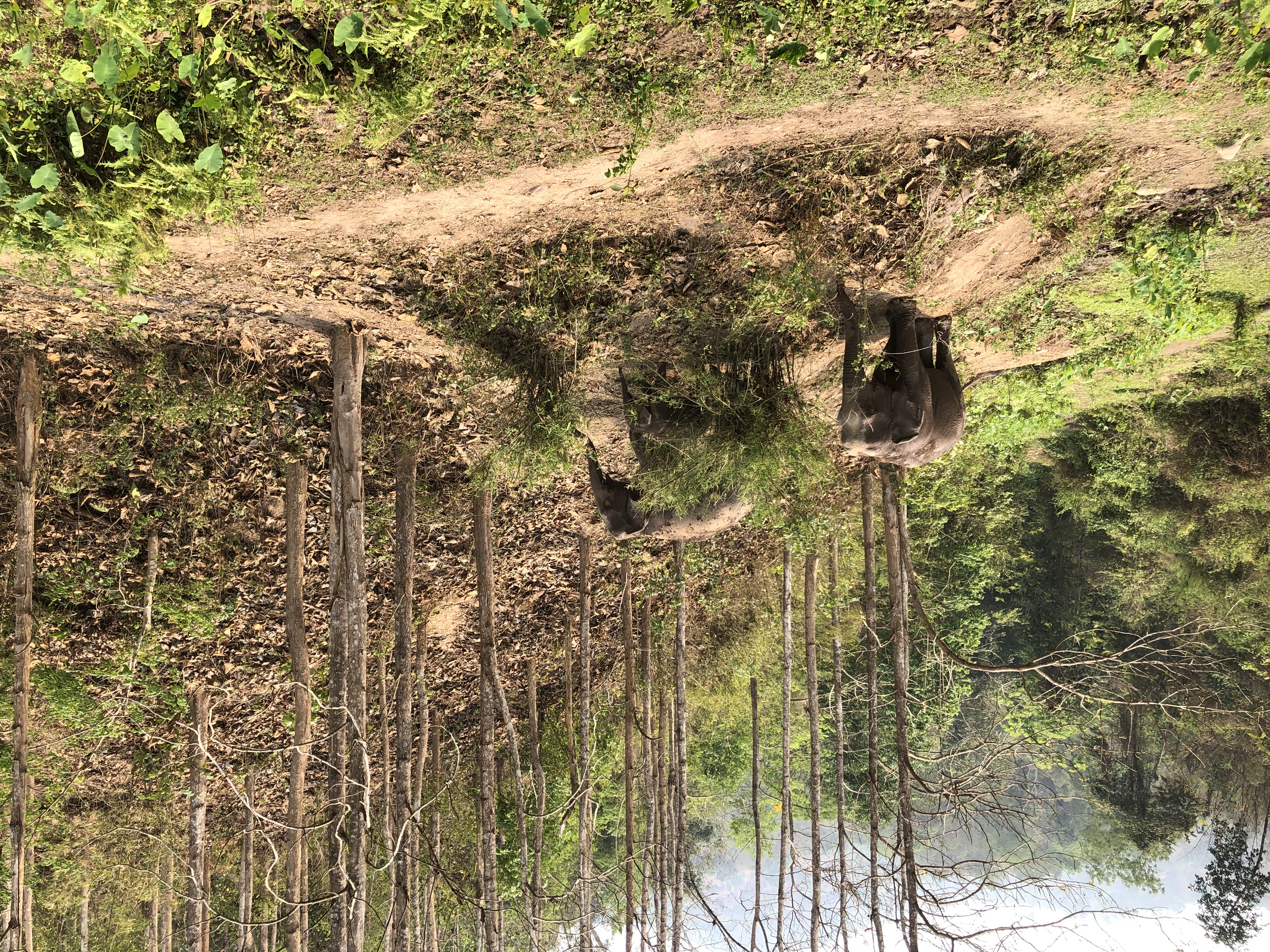
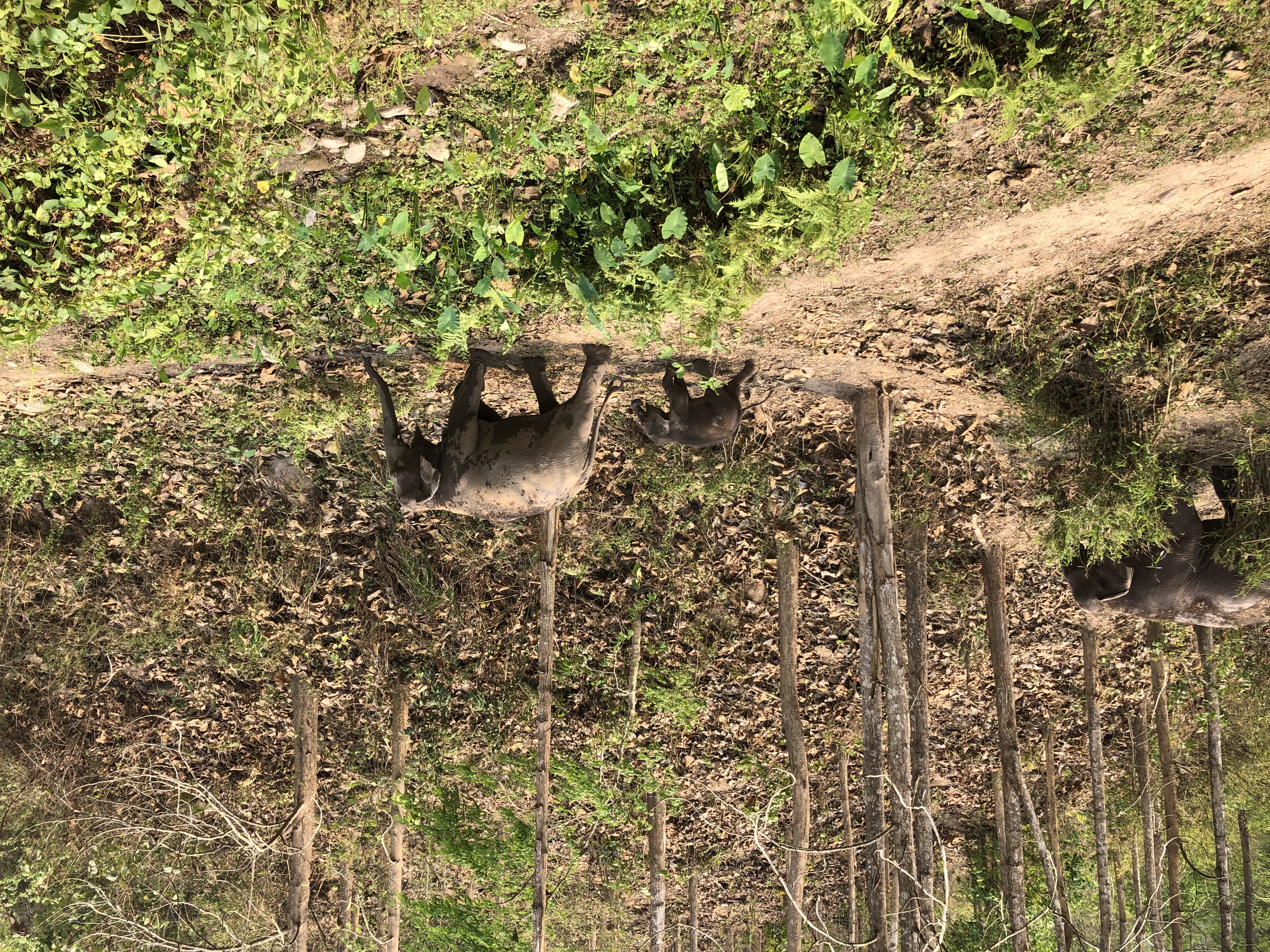
These beautiful creatures just went about their business, which is mostly just walking around eating, walking more, eating more. They are big so just feeding themselves takes most of the day. The Mahouts did supplement their diet a bit but as Helen explained, if you feed them too much they become lazy, and perhaps just as importantly, bored. Which leads to mental health issues.
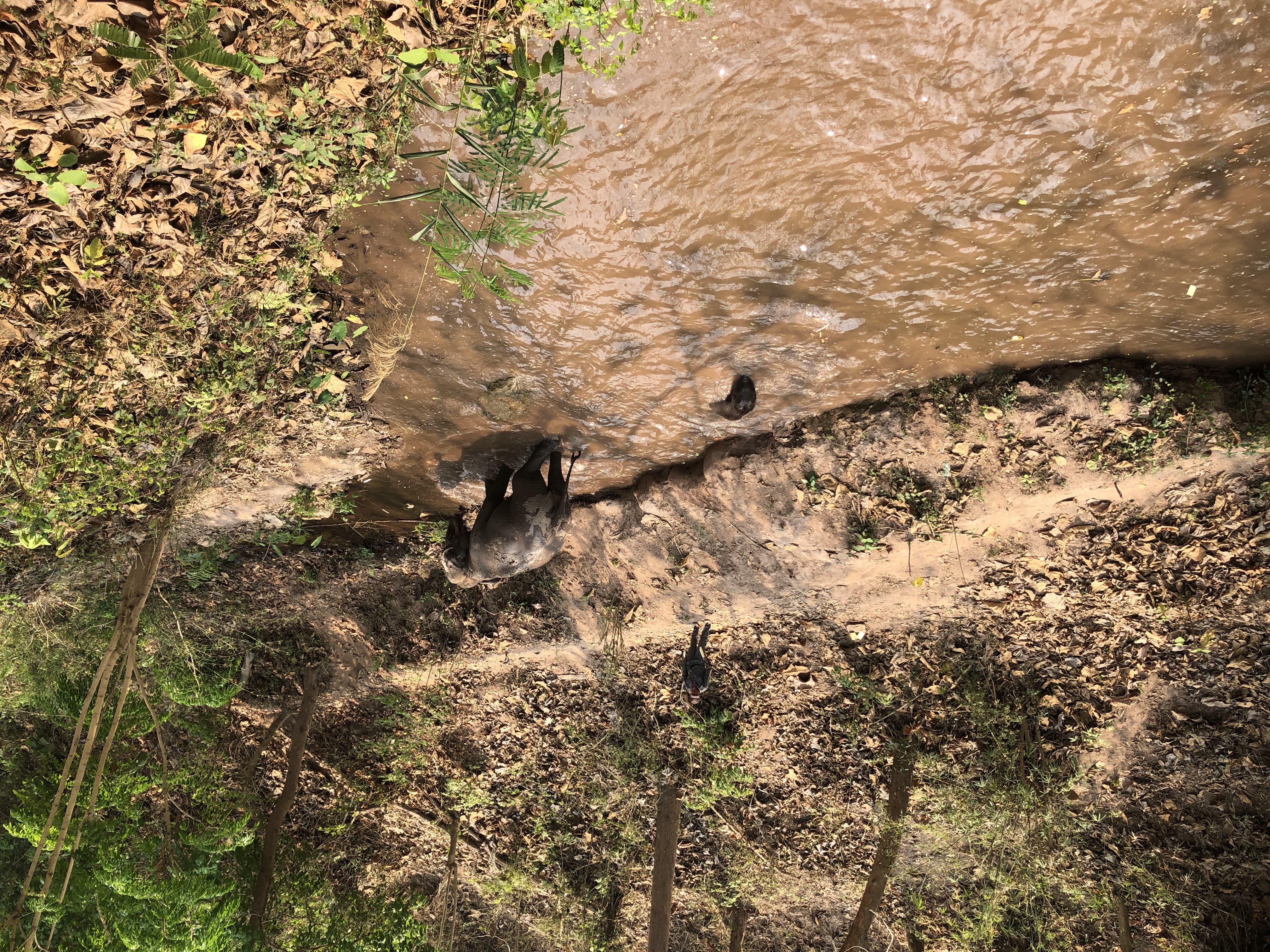
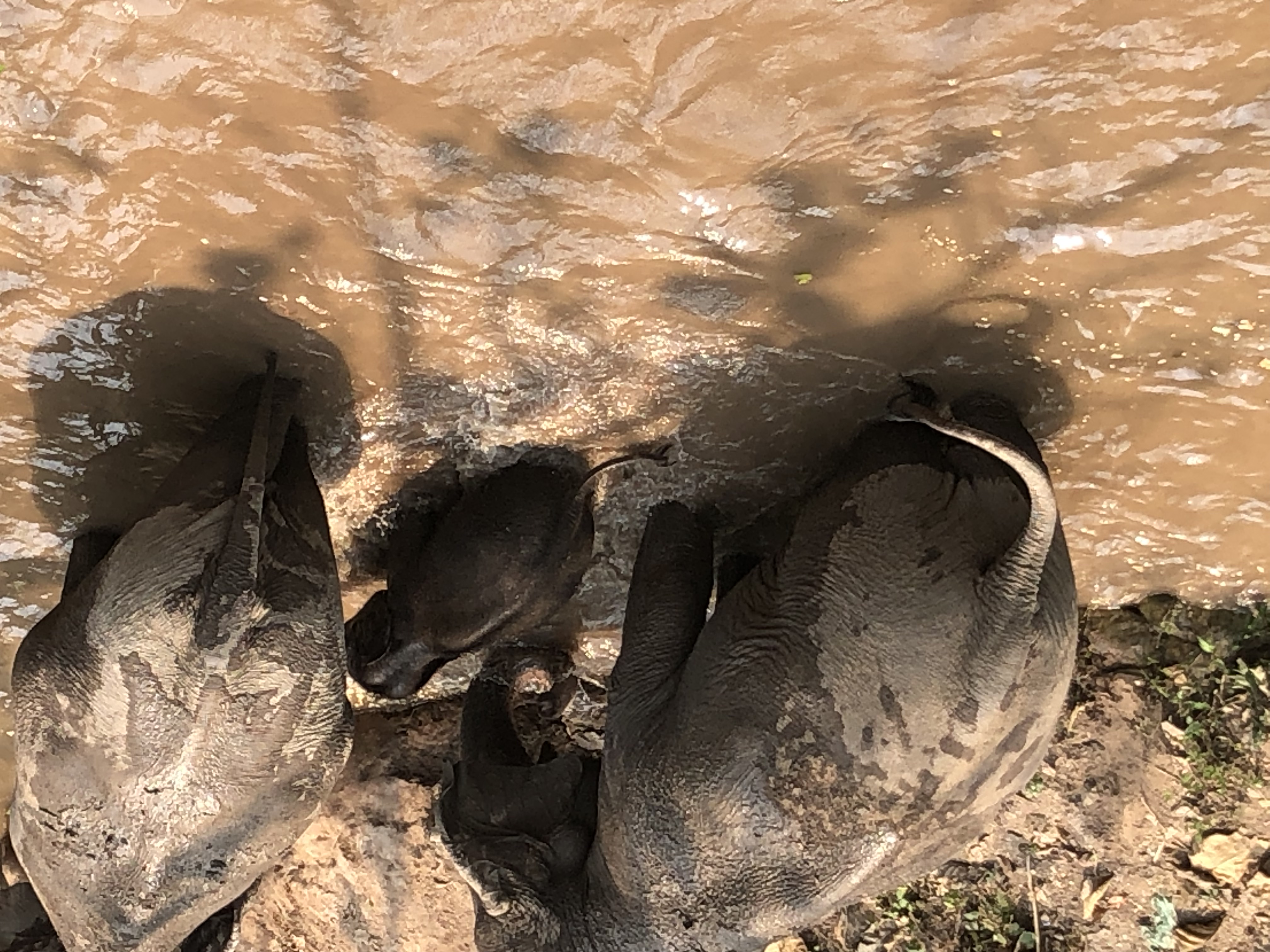
Rather than being at our beck and call, the elephants, to as much an extent as possible, led us around rather than the other way around. Of course there was a certain amount of gentle persuasion, mainly food rewards, for the elephants to show themselves to the tourists. I mean we were paying for an elephant tour and while we were happy to largely leave the animals alone – which extended to not even touching them, and keeping our distance – we did at least expect to see an elephant. And the little tours largely paid for the Mahouts, the elephants’ medical attention, hiring the land, purchasing more elephants at some stage, all the things that were supporting the activities of the park and the overall elephant conservation efforts.
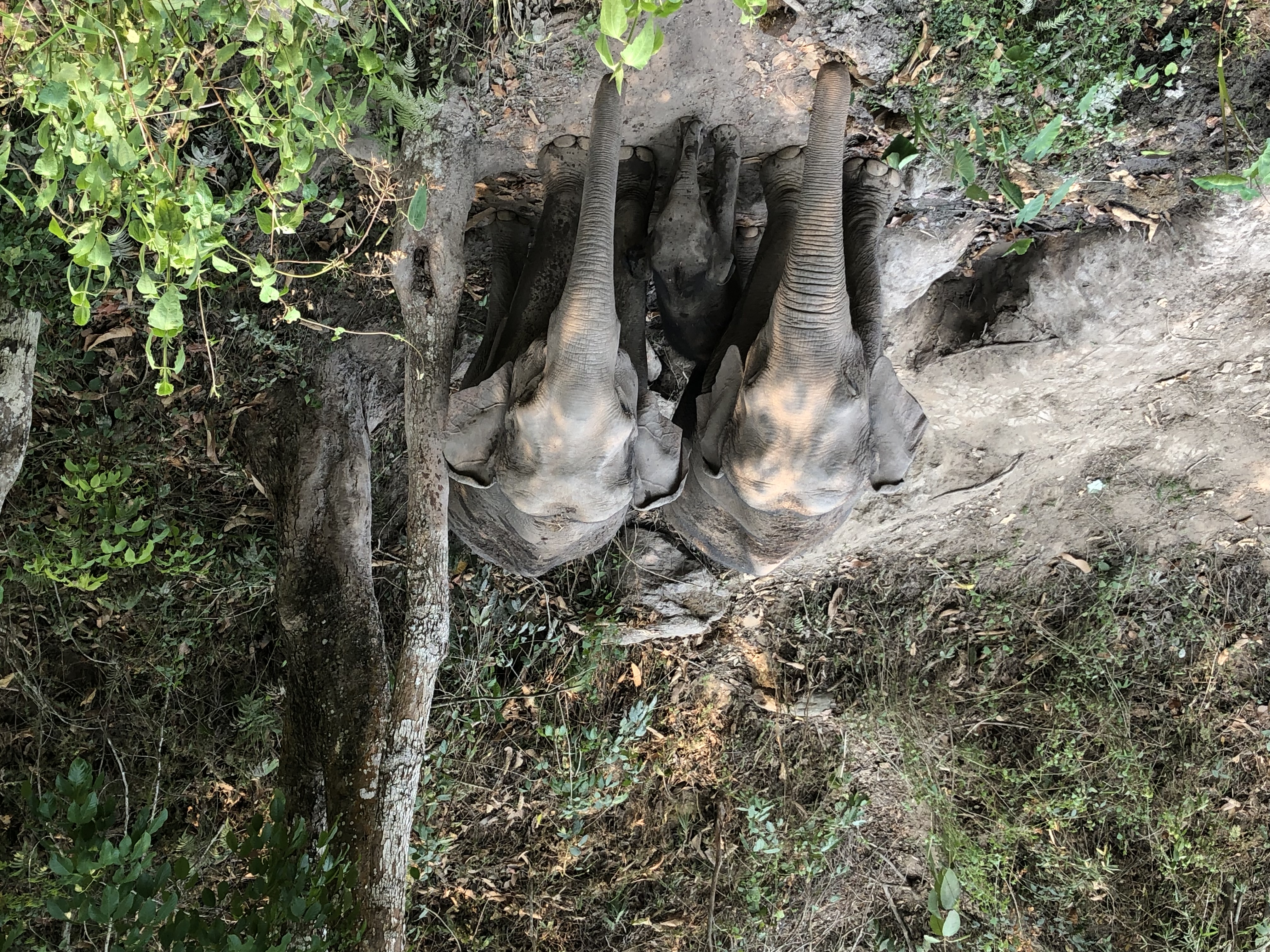
But at that time we weren’t thinking of all that. The ‘aunty’, older female elephant joined the mum and the baby. We were just happy to tag along and watch the elephants go about their business. We were treated to the baby – called Boua – playing around in the mud, maybe just 10 metres from us, under the watchful eye of the mother and aunty. Afterwards they walked along the path to a larger man-made watering spot. The aunty was regularly having to push the baby along the path so she wouldn’t dawdle. But before that, the only other elephant in the park at the time, a male, was introduced. It was fascinating to watch the natural behaviours of the mum and aunty when the male arrived, they stood either side of the baby and shielded her from the male. Apparently males can intentionally or otherwise harm the little babies, and the females had a natural instinct to prevent this.
Helen kept explaining elephant behaviour to us. She told us how they had had to hire another male elephant to impregnate the mother, as the resident male wasn’t able to perform the task effectively. The Mahouts called him a ‘ladyboy’, but it may have just been that his sperm wasn’t up to scratch, or he didn’t have the right technique. She told us how, due to the lack of opportunities to learn behaviours from natural herds (you can imagine with such low numbers in the wild the herds would also be very small and scattered), elephants had lost a lot of ability to fend for themselves, and to learn behaviours from older elephants. Most elephants in Laos were in captivity, working in logging or tourism and were taken from their mothers at an early age and trained up in one of those areas.
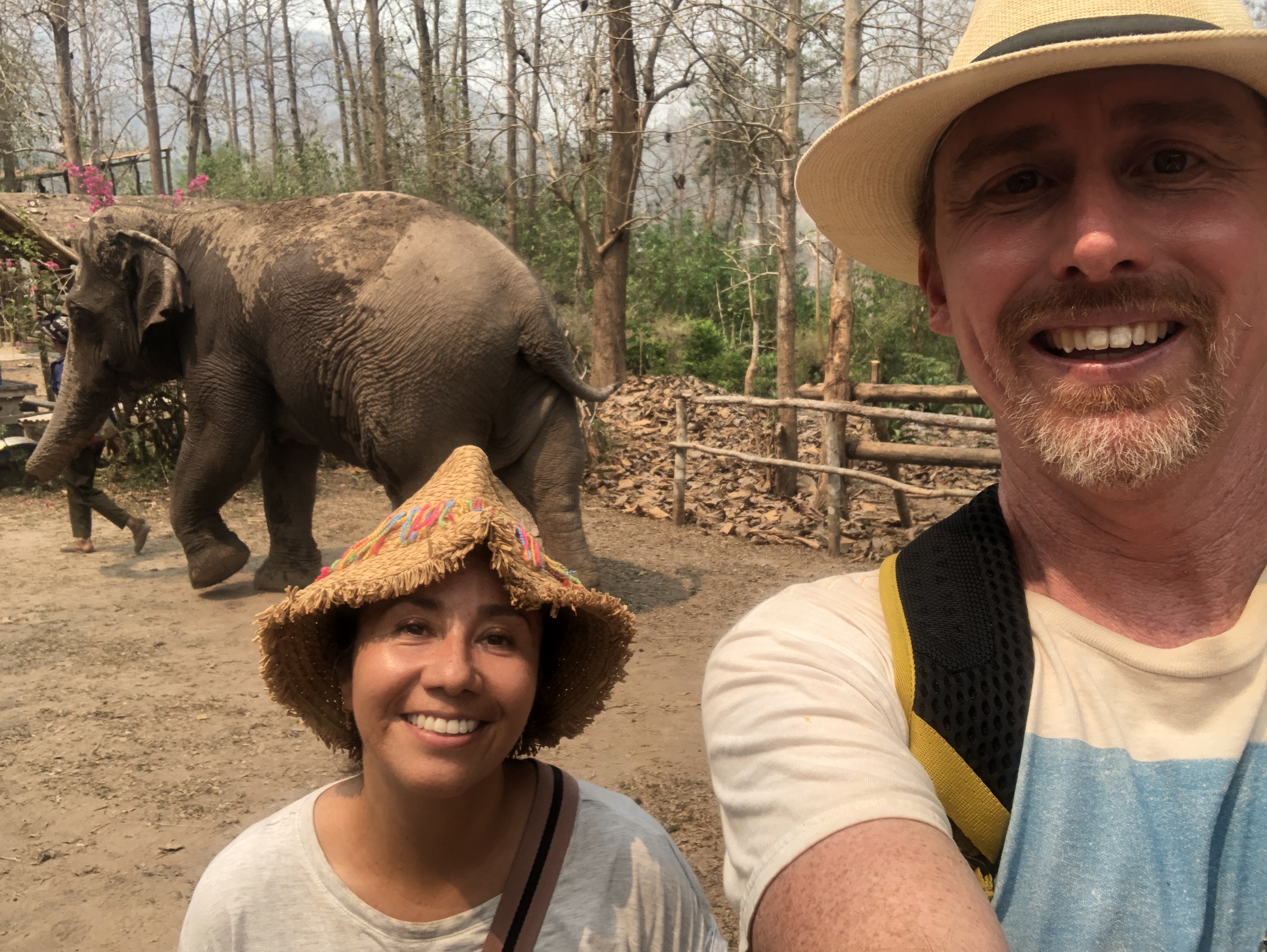
The mum hadn’t even had much of an idea about sex initially (although perhaps we’ve all been there!) and hadn’t been into the whole idea, until the aunty had a word to her and she realised it wasn’t all that bad. When the baby had been born, Helen had joined the Mahouts out in the jungle for weeks before the event to monitor the progress. When the baby was born Helen explained that often they aren’t breathing as their lungs could be full of fluid and that a more experienced mum would gently step on the baby to help expel the fluid. This mum didn’t know how to do that of course and she’d never seen it done before, and when the baby was born she just looked at it, in a heap on the ground in the jungle, wet and at that stage lifeless. Helen and the Mahouts waited as long as they could, and with great risk to their own lives they stepped in and intervened and pressed the baby’s lungs to help expel the fluid and then, the baby breathed for the first time. Had Helen and the Mahout not had had the trust of the mum, things may have turned out quite different.
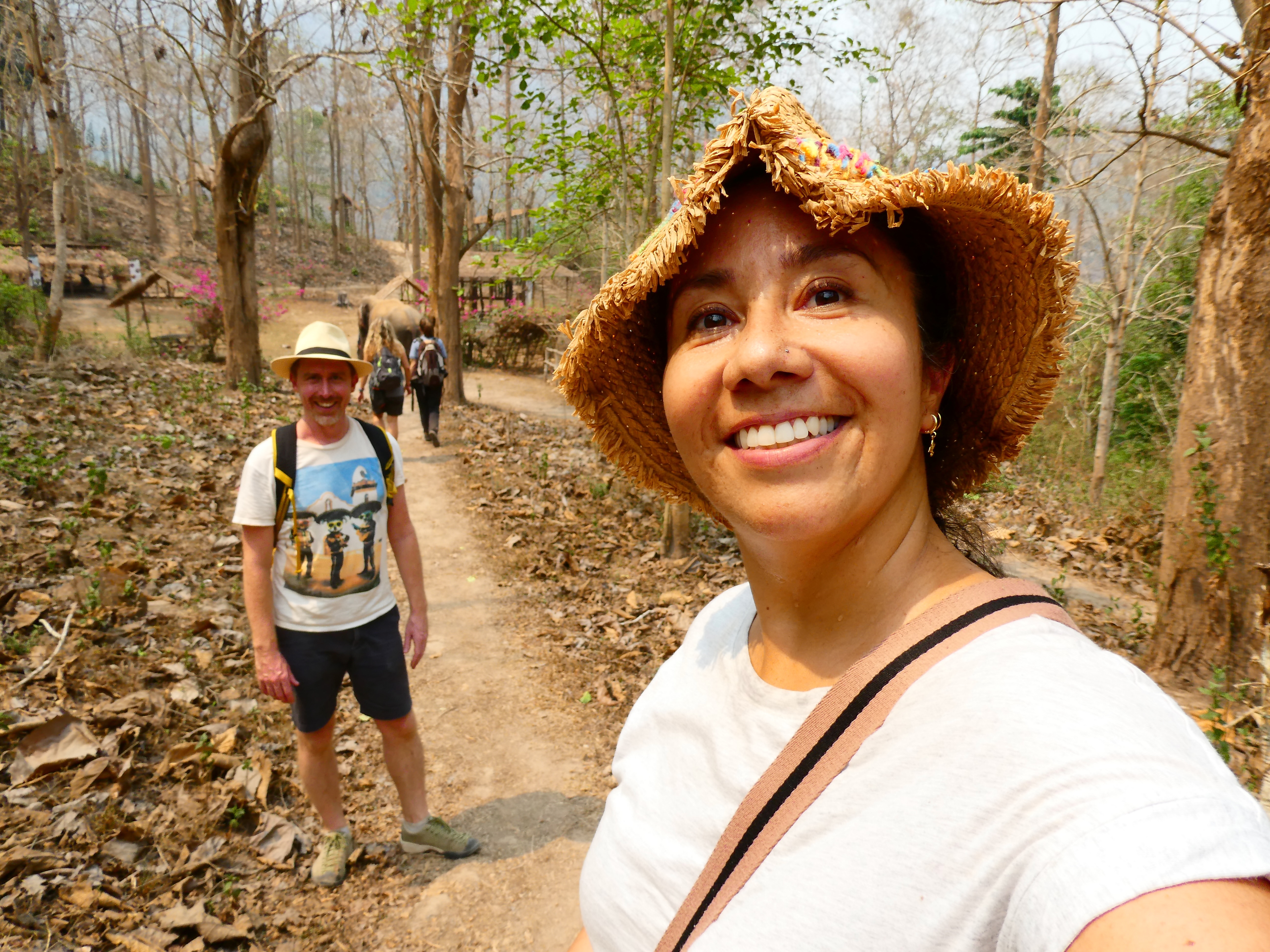
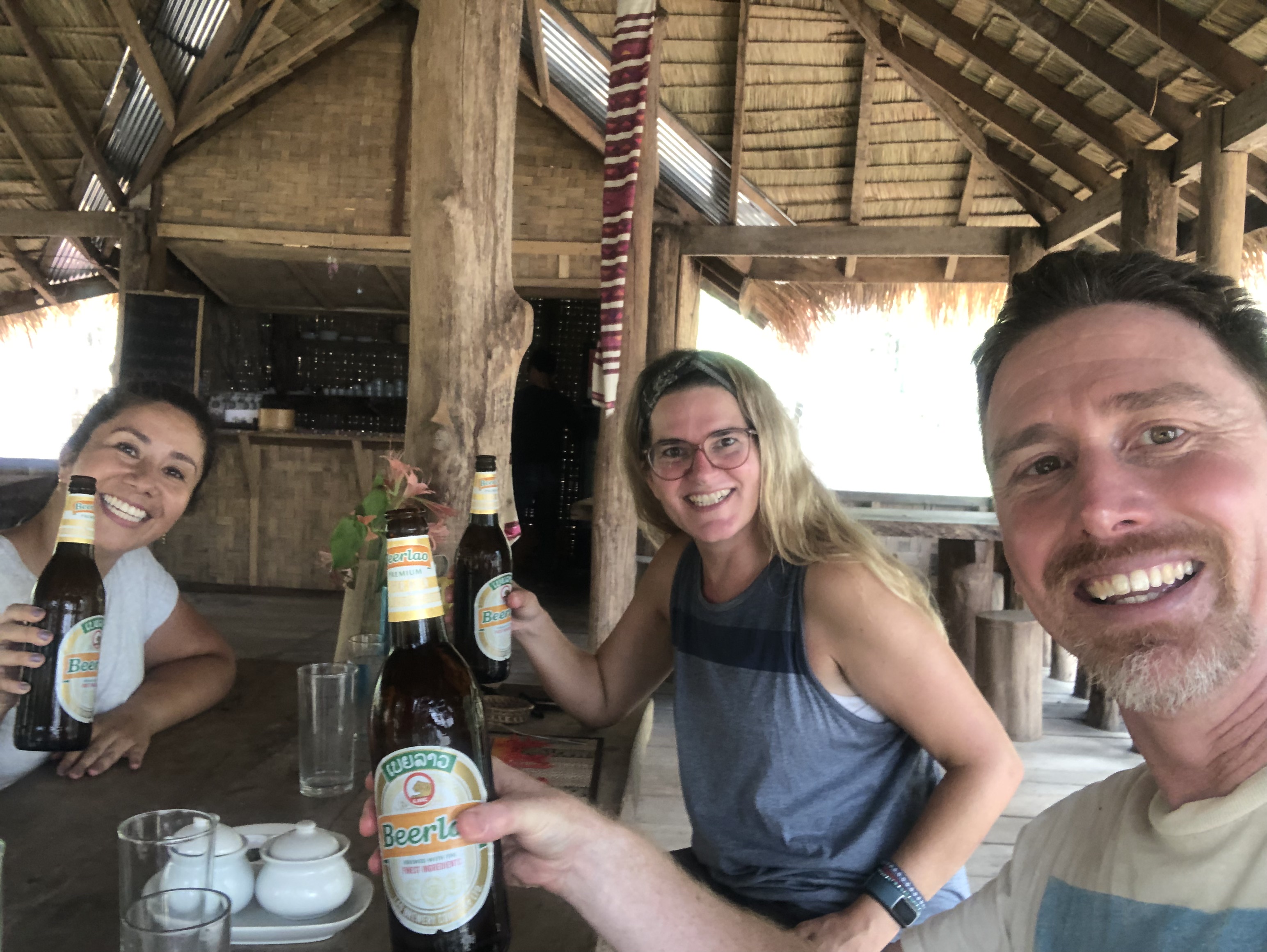
After a few hours we headed up and had some lunch with Helen and our fellow Canadian traveller. It was some laab (I think) again, one of Laos’ national dishes. I think it was chicken. We chatted with Emmanuelle, our newly found friend, and heard of her adventures through Laos. We thought we had been adventurous just going down the Mekong, but she had been to much more remote parts of Laos. I was constantly surprised on our journey how many places people had visited and felt so happy that, post-COVID, people were out and about experiencing different cultures and places again. They had a few local Laotian wares for sale there after lunch, some materials and a guy who made knives from recycled metals. I bought a knife. the Knife would later be subject to much drama, so, if you are ever interested, remember that knife and I will come back and tell you its journey in another blog, which I will eventually write.
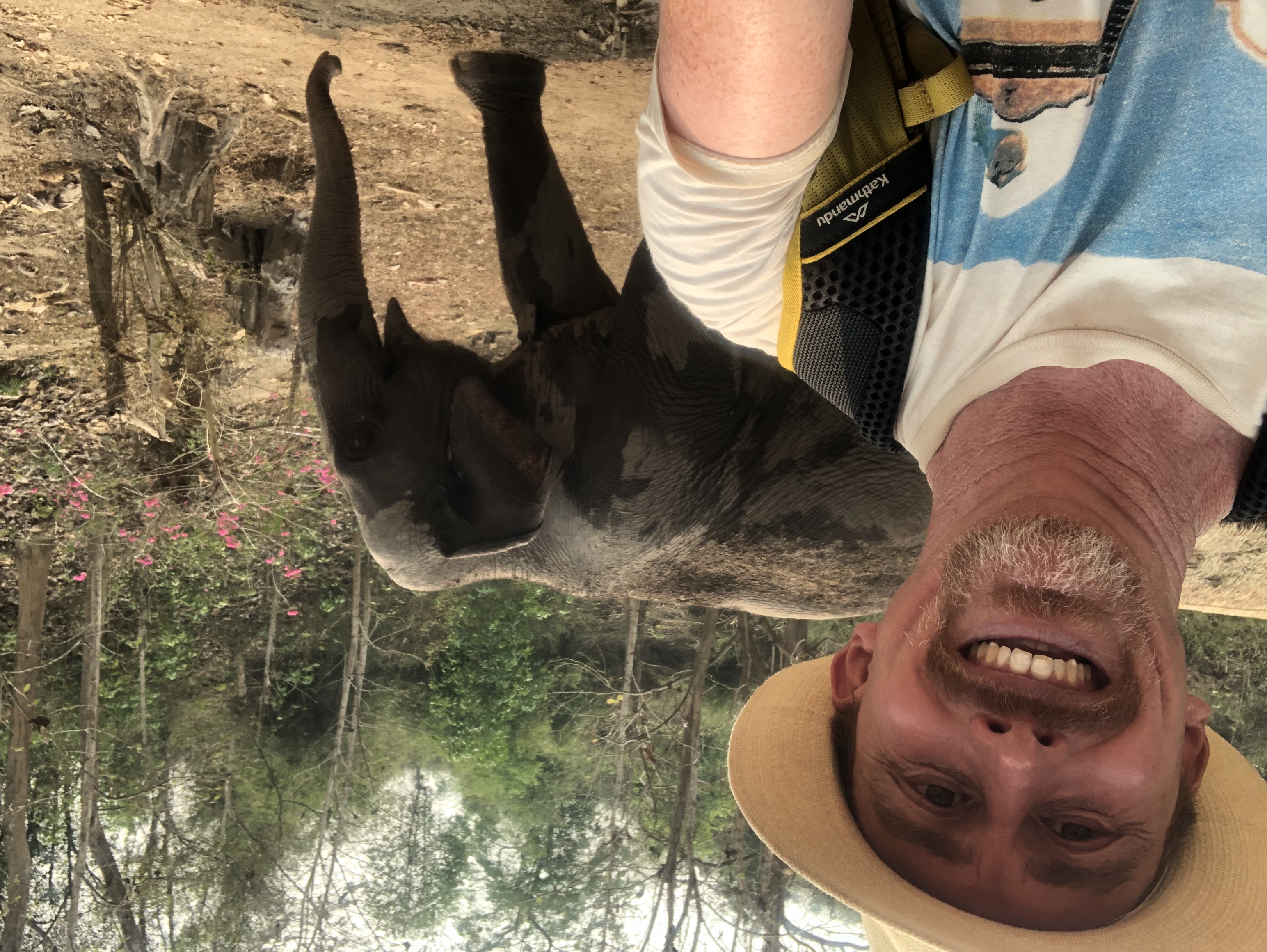
After our laab (or perhaps before) we watched the elephants getting some medical treatment. It took a lot of time and patience to get them to the stage of allowing certain medical treatments. Like us humans they were so keen on needles and the like and they’d have to train them up over months just to get used to certain procedures. I admired the dedication of the Mahouts, and Helen, and everyone there, to make such an effort to add 1 more elephant to 600-800 left in the wild in Laos. Even though they weren’t truly ‘wild’, they were far wilder than those that people get to swim with and take selfies with and ride and the like, the ones that get bored, disengaged and who generally have shitty-ish lives. Like Helen said, why do we need all that tourist stuff that is certainly not in the elephant’s interest and solely to do with us humans wanting a picture to post? And we certainly agreed, we were happy just to see these magnificent creatures in as wild a setting as we are ever likely to see. I’d encourage others to do the same. We got plenty of photos by the way so you won’t even miss out on that aspect. We just didn’t contribute to making the elephant’s lives miserable at the same time.
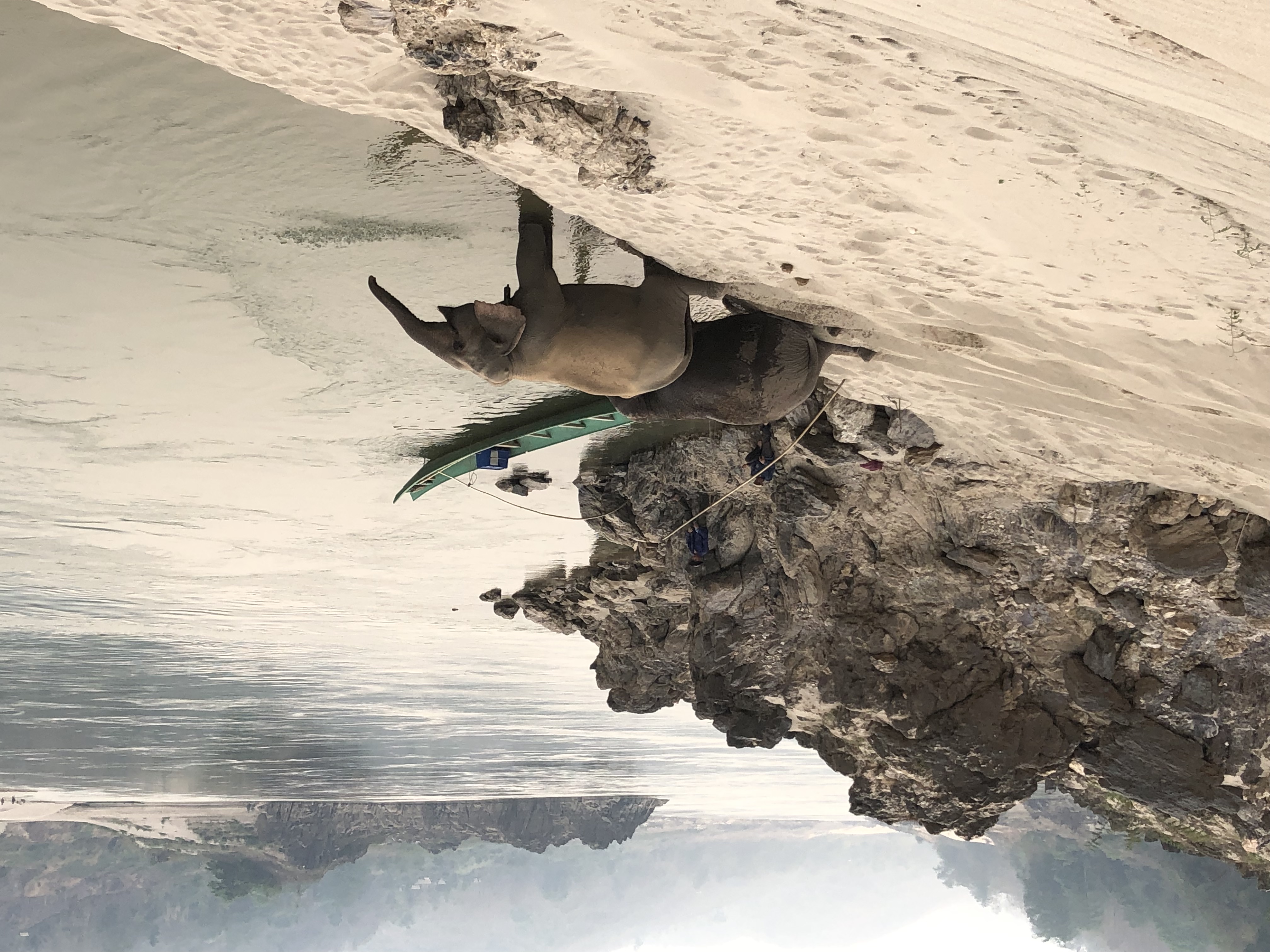
The day ended with a trip down to the banks of the Mekong, where the male and mother elephant slid down the banks of the Mekong and took a dip. I imagine a great relief from the heat. The mum was a bit hesitant and not confident enough to go in by herself without the male about.
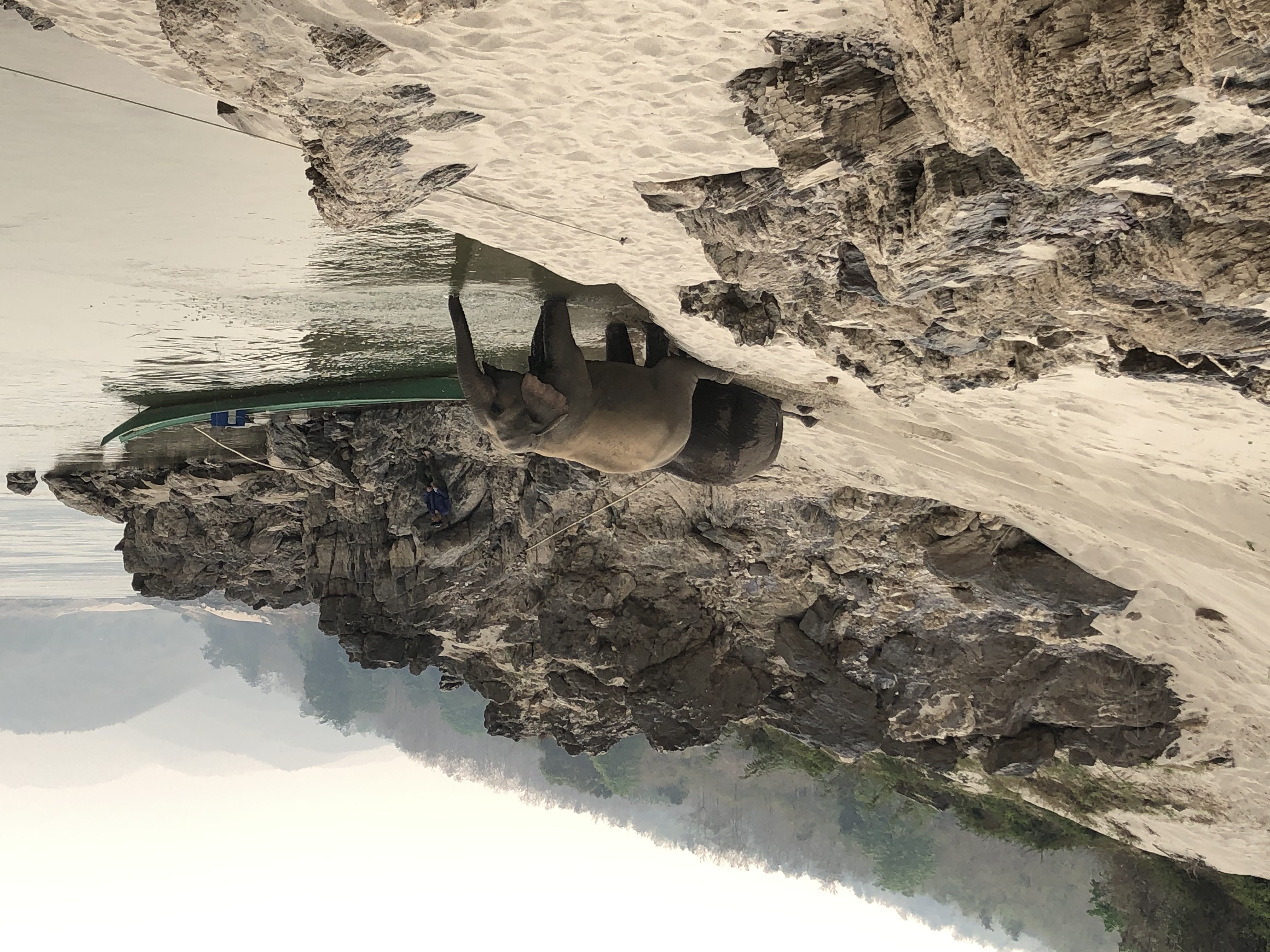
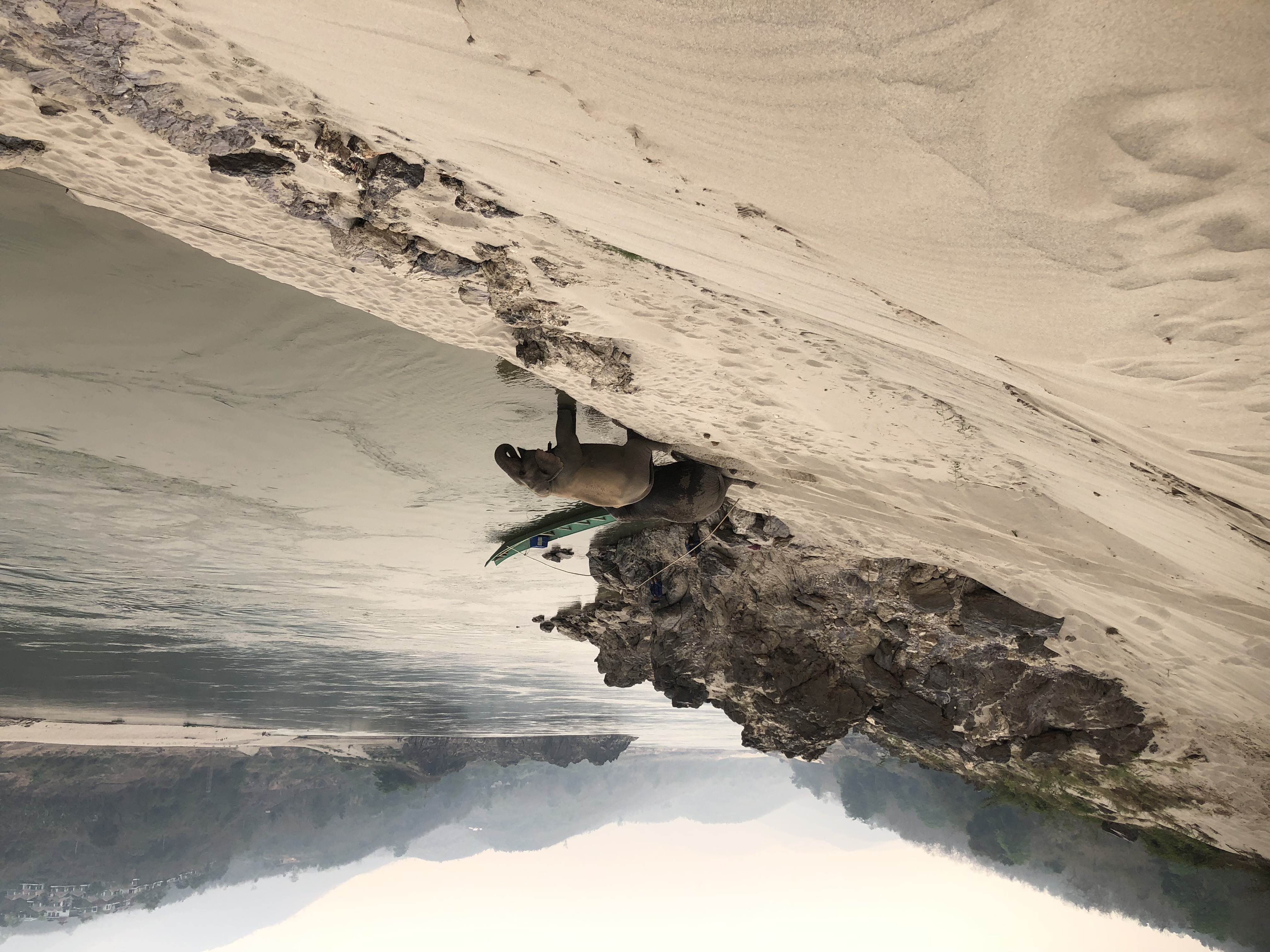
It was undoubtedly the best day of our trip thus far, and if it wasn’t for the crappy showboats, I’d say we’d certainly go back again. I have suggested to my wife that perhaps we fork out the money for the fancy private boat next time so we can go see the elephants again. Let’s see if I can convince her, I’m already hoping we can go back to Laos in a few years.
We headed back across the river to the hotel, changed into our bathers and went straight to the pool. I’d foolishly worn my favourite white shirt with koala mariachis on it that day, and when I took it off I realised the dust and the like had permanently stained it and that it was unlikely to ever see use again. I think I ended up deciding to leave it in Pak Beng, or perhaps I ditched it once we got to Luang Prabang.
Later that evening we walked into town and had dinner with Emmanuelle at the one and only Indian restaurant in town, had a Beerlao or two and then retired to bed, having resigned ourselves to another day in Pak Beng before getting on that boat again for Luang Prabang.
In February 2024, months after visiting the Mekong Elephant Park Emmanuelle sent me a message that the baby elephant Boua had died. It seems the poor little elephant contracted a herpes virus and died in her sleep. There are many tragedies in the world, and this is perhaps not the worst, but thinking of the poor baby elephant the team of Mahouts and Helen were so dedicated to rearing, dying there in the Laotian jungle, was particularly sad for me. I felt for the mother and aunty elephants, and the whole team. I was not alone in my sadness and I could see many messages to the team on Instagram. I hope the future of theses wonderful creatures, in their wild and natural state, and not just as entertainment for tourists, improves enough over the years so the fantasy of Laos’ being the ‘land of a million elephants’ becomes less of a mockery to the few hundred left in the wild and more a reality. But this is not going to happen by buying t-shirts, tea towels, hats and other merchandise with pictures of elephants. It will only happen through the efforts of the good people, and elephants, of places like the Mekong Elephant Park in Pak Beng.
I have some videos of our wonderful experience at the Mekong Elephant Park posted on my Instagram: https://www.instagram.com/p/C3t8jCdhvIp/?next=%2F&img_index=1
